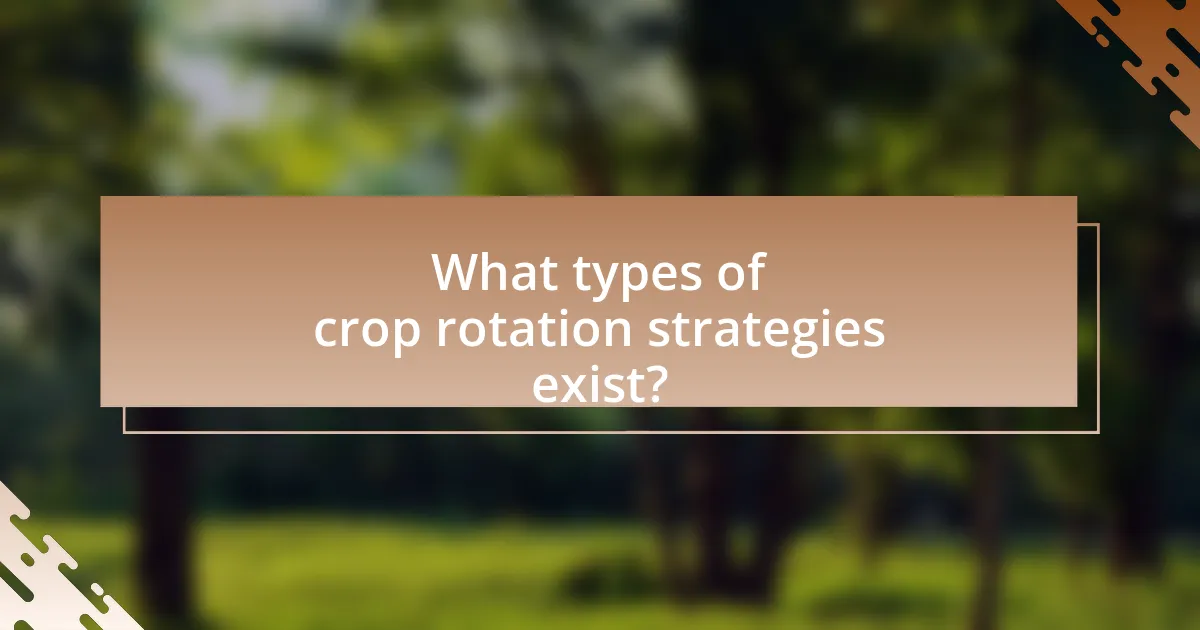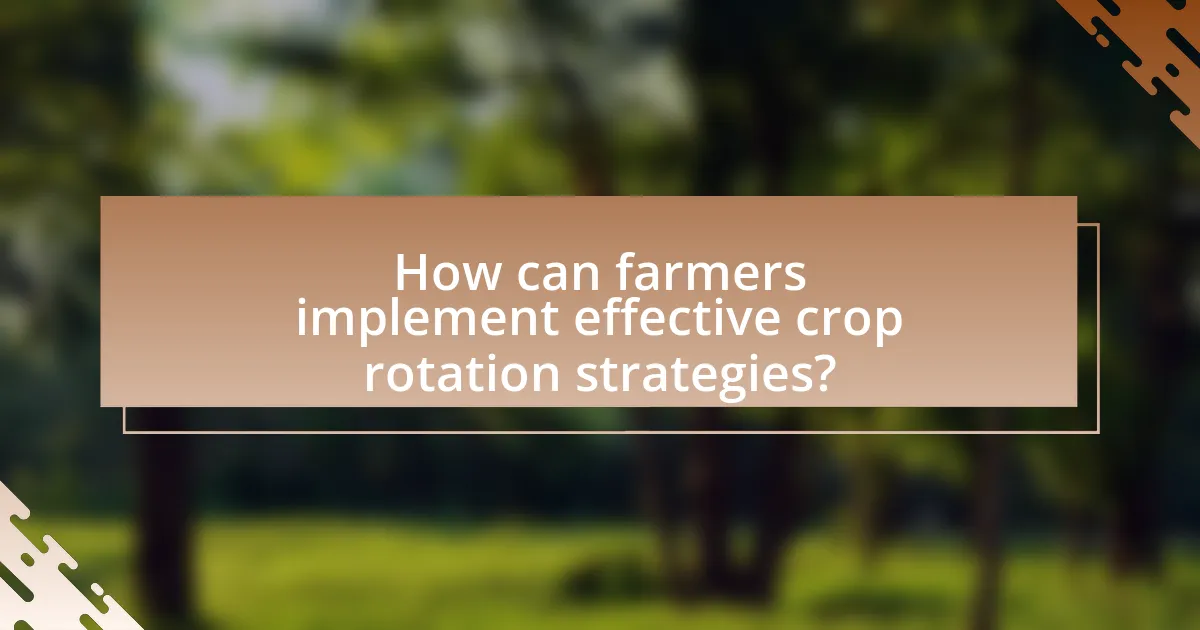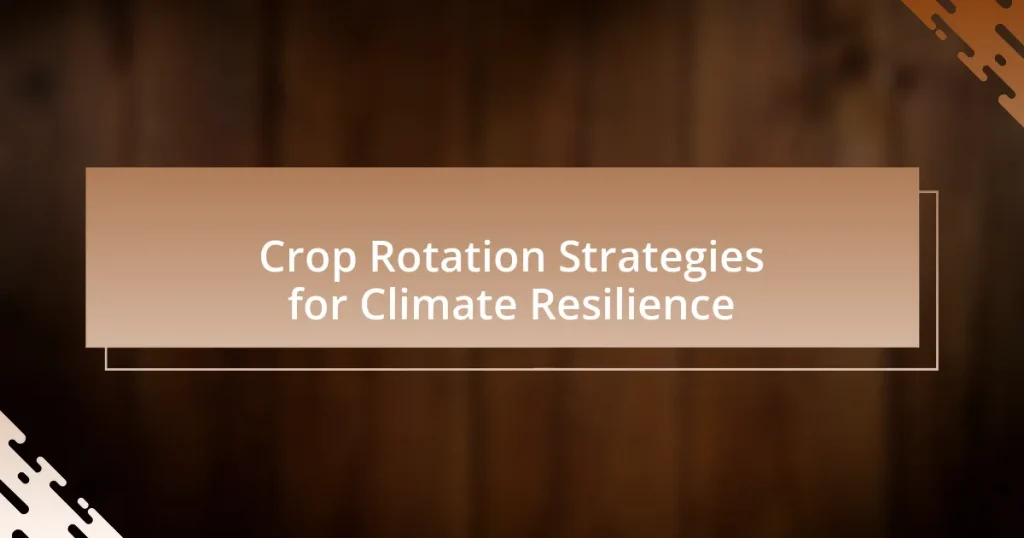Crop rotation strategies for climate resilience involve the systematic alternation of different crops to enhance soil health, improve biodiversity, and reduce pest and disease pressures. These strategies, including the integration of legumes and cover crops, can lead to increased yield stability and soil fertility while mitigating the impacts of climate variability. Effective crop rotation is based on principles such as diversity, nutrient management, and pest control, which collectively contribute to sustainable agricultural practices. The article will explore the benefits of crop rotation, the challenges posed by climate change, and practical tips for farmers to implement these strategies effectively.

What are Crop Rotation Strategies for Climate Resilience?
Crop rotation strategies for climate resilience involve systematically alternating different crops in a specific sequence over time to enhance soil health, reduce pest and disease pressure, and improve biodiversity. These strategies can include rotating legumes with cereals to fix nitrogen in the soil, which enhances fertility and reduces the need for synthetic fertilizers. Research indicates that diverse crop rotations can lead to a 10-20% increase in yield stability under climate stress conditions, as demonstrated in studies by the Rodale Institute. Additionally, incorporating cover crops into rotation can improve soil structure and moisture retention, further contributing to resilience against climate variability.
How do crop rotation strategies contribute to climate resilience?
Crop rotation strategies enhance climate resilience by improving soil health, increasing biodiversity, and reducing pest and disease pressures. These practices lead to better nutrient cycling and soil structure, which can mitigate the impacts of extreme weather events such as droughts and floods. Research indicates that diverse crop rotations can increase soil organic matter by 0.5 to 1.5% annually, enhancing water retention and reducing erosion. Additionally, rotating crops disrupt pest life cycles, leading to lower reliance on chemical pesticides, which further supports ecosystem stability.
What principles underlie effective crop rotation strategies?
Effective crop rotation strategies are underpinned by principles such as diversity, nutrient management, pest and disease control, and soil health enhancement. Diversity in crop selection reduces the risk of pest and disease outbreaks, as different crops can disrupt the life cycles of specific pests. Nutrient management is achieved by alternating deep-rooted and shallow-rooted crops, which optimizes nutrient uptake and replenishes soil fertility. Additionally, rotating crops can break pest and disease cycles, minimizing reliance on chemical controls. Lastly, enhancing soil health through organic matter addition and improved soil structure promotes resilience against climate variability. These principles collectively contribute to sustainable agricultural practices that improve productivity and environmental health.
How does crop diversity enhance soil health in rotation systems?
Crop diversity enhances soil health in rotation systems by improving nutrient cycling, increasing organic matter, and reducing soil erosion. Different crops have varying root structures and nutrient requirements, which leads to a more balanced nutrient profile in the soil. For instance, legumes fix nitrogen, enriching the soil for subsequent crops. Additionally, diverse root systems help prevent soil compaction and promote better water infiltration. Research indicates that fields with diverse crop rotations can increase soil organic carbon levels by up to 30%, thereby enhancing soil structure and fertility. This diversity also disrupts pest and disease cycles, reducing the need for chemical inputs and promoting a healthier soil ecosystem.
Why is climate resilience important for agriculture?
Climate resilience is important for agriculture because it enables farmers to adapt to changing climate conditions, ensuring food security and sustainable production. As climate change leads to increased frequency of extreme weather events, such as droughts and floods, resilient agricultural practices help mitigate these impacts. For instance, studies show that implementing climate-resilient strategies, like crop rotation, can enhance soil health and improve yields by diversifying crops and reducing pest pressures. This adaptability is crucial for maintaining agricultural productivity and supporting livelihoods in the face of climate variability.
What challenges does climate change pose to traditional farming practices?
Climate change poses significant challenges to traditional farming practices, primarily through altered weather patterns, increased pest and disease prevalence, and soil degradation. These changes lead to unpredictable growing seasons, which can disrupt crop yields and threaten food security. For instance, rising temperatures can cause heat stress in crops, while erratic rainfall can lead to droughts or flooding, both of which adversely affect agricultural productivity. Additionally, the increased frequency of extreme weather events, such as hurricanes and storms, can damage infrastructure and reduce arable land. Research indicates that these climate-related factors are projected to decrease global crop yields by up to 30% by 2050 if no adaptive measures are taken.
How can crop rotation mitigate the effects of climate variability?
Crop rotation can mitigate the effects of climate variability by enhancing soil health, improving biodiversity, and increasing resilience to pests and diseases. By alternating different crops, farmers can improve soil structure and nutrient availability, which helps maintain productivity during extreme weather events. Research indicates that diverse cropping systems can reduce the risk of crop failure by up to 30% in variable climates, as demonstrated in studies conducted by the Food and Agriculture Organization. This practice also promotes beneficial microorganisms in the soil, which can further enhance plant health and adaptability to changing climate conditions.

What types of crop rotation strategies exist?
There are several types of crop rotation strategies, including simple rotation, complex rotation, and cover cropping. Simple rotation involves alternating two or more crops in a specific sequence, which helps in pest and disease management. Complex rotation includes a wider variety of crops over multiple seasons, enhancing soil health and biodiversity. Cover cropping, where non-harvested crops are planted to improve soil structure and fertility, is also a key strategy. Research indicates that these strategies can significantly improve soil quality and crop yields, contributing to climate resilience in agriculture.
How do different crop rotation patterns affect soil fertility?
Different crop rotation patterns significantly affect soil fertility by enhancing nutrient availability, improving soil structure, and reducing pest and disease pressure. For instance, rotating legumes with cereals can increase nitrogen levels in the soil due to the nitrogen-fixing ability of legumes, which can lead to higher crop yields. Research conducted by the Rodale Institute found that diverse crop rotations can improve soil organic matter by 30% compared to continuous cropping systems, thereby enhancing soil fertility. Additionally, crop rotations can disrupt pest cycles, reducing the need for chemical fertilizers and pesticides, which further contributes to sustainable soil health.
What are the benefits of legume-based rotations?
Legume-based rotations enhance soil fertility, improve crop yields, and reduce the need for synthetic fertilizers. Legumes, such as beans and peas, fix atmospheric nitrogen in the soil, enriching it and promoting healthier growth for subsequent crops. Research indicates that incorporating legumes in crop rotations can increase overall yields by 10-20% compared to continuous cropping systems. Additionally, these rotations can suppress weeds and pests, leading to lower pesticide use and promoting sustainable agricultural practices.
How do cover crops fit into crop rotation strategies?
Cover crops are integral to crop rotation strategies as they enhance soil health, reduce erosion, and improve nutrient cycling. By planting cover crops between main crop cycles, farmers can prevent soil degradation and suppress weeds, which contributes to sustainable agricultural practices. Research indicates that cover crops can increase soil organic matter by 0.1 to 0.3% per year, leading to improved soil structure and fertility. Additionally, studies show that cover crops can reduce nitrogen leaching by up to 50%, thereby enhancing nutrient retention in the soil. This integration of cover crops into crop rotation not only supports climate resilience but also promotes long-term agricultural productivity.
What role do local conditions play in selecting crop rotation strategies?
Local conditions significantly influence the selection of crop rotation strategies by determining soil health, climate suitability, and pest management. For instance, soil type affects nutrient availability and water retention, which are critical for crop growth. In regions with heavy clay soils, farmers may choose deep-rooted crops to improve soil structure, while sandy soils may favor crops that require less water. Additionally, local climate conditions, such as temperature and rainfall patterns, dictate which crops can thrive in a given area, leading to rotations that maximize yield and minimize risk. Research indicates that tailored crop rotations can enhance resilience against climate variability, as seen in studies where diverse rotations improved soil organic matter and reduced pest populations, thereby increasing overall farm productivity.
How can farmers assess their specific environmental conditions?
Farmers can assess their specific environmental conditions by utilizing soil testing, climate data analysis, and remote sensing technologies. Soil testing provides detailed information on nutrient levels, pH, and organic matter, which are critical for determining soil health and suitability for various crops. Climate data analysis involves examining historical weather patterns, temperature ranges, and precipitation levels to understand the microclimate of the farming area. Remote sensing technologies, such as satellite imagery, allow farmers to monitor land use, vegetation health, and moisture levels, providing a comprehensive view of environmental conditions. These methods collectively enable farmers to make informed decisions about crop rotation strategies that enhance climate resilience.
What factors should be considered when planning a rotation schedule?
When planning a rotation schedule, key factors include soil health, crop compatibility, pest and disease management, and climatic conditions. Soil health is crucial as different crops contribute varying nutrients and organic matter, influencing soil fertility and structure. Crop compatibility ensures that successive crops do not deplete the same nutrients or attract similar pests, which can lead to increased disease pressure. Effective pest and disease management is achieved by rotating crops that disrupt pest life cycles, reducing reliance on chemical controls. Lastly, climatic conditions, including temperature and rainfall patterns, must be considered to select crops that are well-suited to the local environment, enhancing resilience against climate variability.

How can farmers implement effective crop rotation strategies?
Farmers can implement effective crop rotation strategies by systematically alternating different crops in a specific sequence over time to improve soil health and reduce pest and disease pressure. This practice enhances nutrient cycling, as different crops have varying nutrient requirements and root structures, which can lead to improved soil structure and fertility. Research indicates that rotating legumes with cereals can increase nitrogen availability in the soil, benefiting subsequent crops. For instance, a study published in the “Agronomy Journal” by Drinkwater et al. (1998) demonstrated that crop rotation with legumes increased yields by 20% compared to continuous cropping systems. By planning rotations that include a mix of deep and shallow-rooted plants, farmers can optimize water usage and minimize erosion, contributing to greater climate resilience.
What best practices should farmers follow for successful crop rotation?
Farmers should follow several best practices for successful crop rotation, including selecting diverse crops, planning rotations based on nutrient needs, and incorporating cover crops. Diverse crop selection helps break pest and disease cycles, while planning rotations according to nutrient requirements ensures soil health and fertility. For instance, rotating nitrogen-fixing legumes with nutrient-demanding crops like corn can enhance soil nitrogen levels. Additionally, incorporating cover crops during off-seasons can prevent soil erosion and improve organic matter. Research indicates that these practices can lead to increased yields and improved soil structure, contributing to long-term agricultural sustainability.
How can farmers monitor and evaluate the effectiveness of their rotation plans?
Farmers can monitor and evaluate the effectiveness of their rotation plans by analyzing crop yields, soil health indicators, and pest and disease prevalence. By comparing yields from different crop rotations over multiple seasons, farmers can identify which combinations produce the best results. Soil health can be assessed through tests measuring nutrient levels, organic matter, and microbial activity, which indicate the impact of rotation on soil quality. Additionally, tracking pest and disease occurrences helps determine if rotation strategies effectively disrupt pest cycles and reduce infestations. Research shows that diverse crop rotations can enhance soil fertility and reduce reliance on chemical inputs, leading to more sustainable farming practices.
What resources are available to assist farmers in crop rotation planning?
Farmers can access various resources to assist in crop rotation planning, including agricultural extension services, online tools, and research publications. Agricultural extension services provide localized advice and support tailored to specific regions, helping farmers understand the best crop combinations for their soil and climate conditions. Online tools, such as the USDA’s Crop Rotation Planner, offer interactive platforms for farmers to visualize and plan their crop rotations effectively. Research publications, like those from the Journal of Sustainable Agriculture, provide evidence-based strategies and case studies that demonstrate the benefits of specific crop rotations in enhancing soil health and resilience to climate change.
What common challenges do farmers face when adopting crop rotation?
Farmers face several common challenges when adopting crop rotation, including knowledge gaps, economic constraints, and pest management issues. Knowledge gaps arise as many farmers may lack the necessary information or training on effective crop rotation practices, which can lead to suboptimal implementation. Economic constraints often manifest as the initial costs associated with changing planting schedules and crop types, which can deter farmers from making the switch. Additionally, pest management issues can complicate crop rotation, as some pests may adapt to new crops, requiring farmers to develop new strategies for control. These challenges can hinder the successful adoption of crop rotation, impacting overall agricultural productivity and sustainability.
How can farmers overcome resistance to change in traditional practices?
Farmers can overcome resistance to change in traditional practices by implementing education and demonstration programs that showcase the benefits of new methods. Research indicates that when farmers participate in hands-on workshops and see successful outcomes from innovative practices, such as crop rotation, they are more likely to adopt these strategies. For instance, a study published in the Journal of Agricultural Education and Extension found that farmers who engaged in peer-to-peer learning and field demonstrations reported a 30% increase in the adoption of sustainable practices. This evidence supports the effectiveness of targeted education in facilitating change among farmers.
What strategies can be employed to manage pests and diseases in rotation systems?
Crop rotation systems can effectively manage pests and diseases through several strategies, including the use of diverse crop species, timing of planting, and incorporation of cover crops. Diverse crop species disrupt pest life cycles and reduce the likelihood of disease establishment, as different crops attract different pests and pathogens. Timing of planting can also be adjusted to avoid peak pest populations, thereby minimizing damage. Additionally, incorporating cover crops can enhance soil health and biodiversity, which further supports natural pest control mechanisms. Research indicates that these practices can lead to a significant reduction in pest populations and disease incidence, promoting healthier crop yields and sustainable farming practices.
What practical tips can enhance crop rotation strategies for climate resilience?
Implementing diverse crop rotations enhances climate resilience by improving soil health, reducing pest pressures, and optimizing resource use. Farmers can rotate deep-rooted and shallow-rooted crops to maximize nutrient uptake and minimize soil erosion. Incorporating legumes into the rotation can enhance nitrogen fixation, thereby reducing the need for synthetic fertilizers. Additionally, planting cover crops during off-seasons can prevent soil degradation and improve moisture retention. Research indicates that diverse crop rotations can increase yields by up to 20% under climate stress conditions, demonstrating their effectiveness in promoting agricultural sustainability.










